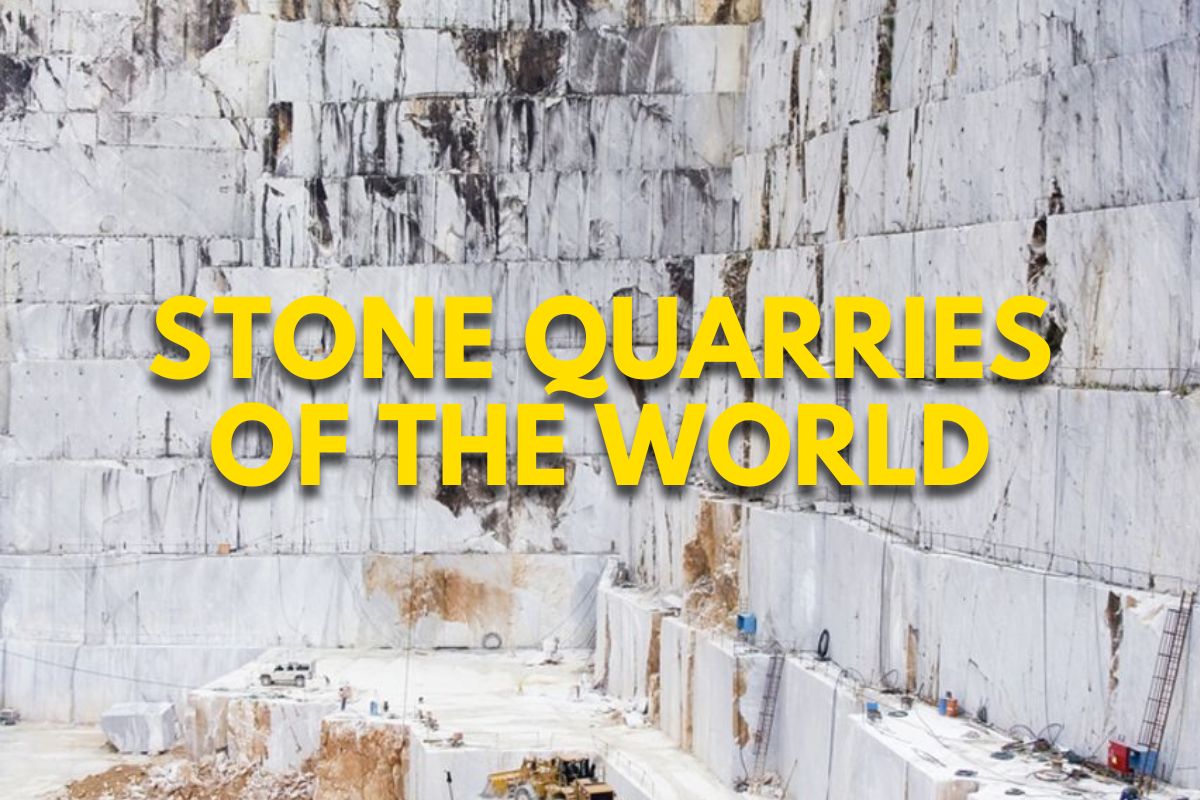
Imagine a world without the marvels of stone architecture – the towering pyramids, majestic temples, and iconic sculptures that have stood the test of time.
These enduring wonders were born from the depths of the earth, carved from quarries that have shaped landscapes and civilizations for millennia.
Embark on a journey through the world’s most remarkable stone quarries, where the raw power of nature meets human ingenuity, unveiling the stories behind these awe-inspiring sites.
Historical Importance of Stone Quarries
Stone quarries have played a pivotal role in shaping the historical landscapes and architectural marvels of civilizations across the globe. From the ancient Egyptians who meticulously quarried limestone to construct the great pyramids of Giza to the Greeks who sourced pristine marble from Mount Pentelicus to erect the Parthenon, these sites were instrumental in the creation of enduring monuments that have withstood the test of time.
The historical importance of stone quarries extends beyond mere construction. They were often the economic lifeblood of entire regions, providing employment and driving trade.
The Romans, for instance, established a vast network of quarries throughout their empire, supplying stone for their aqueducts, roads, and magnificent structures like the Colosseum.
Moreover, the process of quarrying itself was a remarkable feat of engineering and organization. Ancient quarry workers developed ingenious techniques for extracting and transporting massive stone blocks, sometimes weighing hundreds of tons.
These methods, passed down through generations, represent the earliest forms of large-scale mining and construction practices.
Stone quarries also offer a unique window into the past, preserving tools, inscriptions, and even skeletal remains that provide invaluable insights into the lives and working conditions of those who toiled within these sites. As such, they serve as outdoor museums, offering a tangible connection to the ingenuity and perseverance of our ancestors.
Natural Stone Deposits and Geological Formations
Natural stone deposits and geological formations play a crucial role in the existence and significance of stone quarries around the world. These sites are not mere excavations but a testament to the earth’s profound geological processes that have shaped its landscapes over millions of years.
The type of stone found in a quarry is largely determined by the region’s geological history and the specific rock formations present. Igneous rocks, such as granite and basalt, are formed from the cooling and solidification of molten magma, while sedimentary rocks like limestone and sandstone are created through the accumulation and compaction of organic and mineral particles over time.
Metamorphic rocks, including marble and slate, transform intense heat and pressure, altering their original composition.
The physical and chemical properties of these stones, including their color, texture, and durability, are directly influenced by the unique geological conditions under which they were formed.
For instance, the distinct veining patterns found in marble are a result of the intense metamorphic processes that transformed limestone over millions of years.
Furthermore, the way these stone deposits are situated within the earth’s crust determines the feasibility and methods of quarrying. Some quarries are open-pit mines, where the stone is extracted from the surface, while others are underground operations, requiring tunneling and advanced mining techniques.
Famous Stone Quarries Around the World
- Carrara Marble Quarries, Italy: These ancient quarries in the Apuan Alps have provided the world’s finest marble for centuries, used in masterpieces like Michelangelo’s David.
- Mons Claudianus, Egypt: Dating back to 30 BCE, this Roman quarry was a major source of granite for obelisks, colossal statues, and monuments across the empire.
- Barre Granite Quarries, USA: These Vermont quarries produced a distinct gray granite prized for monuments and memorials, including many in Washington D.C.
- Chateau Gaillard Quarries, France: Chalky stone from these medieval quarries was used to construct the famous Chateau Gaillard, a strategically located fortress overlooking the Seine River.
- Penrhyn Slate Quarry, Wales: One of the largest slate quarries in the world, providing high-quality roofing material for buildings across Britain for over 400 years.
- Makapansgat Caves, South Africa: This prehistoric limestone quarry contains fossils and tools dating back millions of years, offering insights into human origins.
- Rockville White Granite Quarry, USA: This massive granite quarry in Minnesota supplied stone for iconic structures like the Brooklyn Bridge and Washington Monument.
- Mons Porphyrites, Egypt: An ancient Egyptian quarry once the sole source of the valuable porphyry stone used in imperial Roman sculpture and architecture.
Marble Quarries of Carrara, Italy
These ancient quarries in the Apuan Alps have provided the world’s finest marble for centuries, used in masterpieces like Michelangelo’s David.
Granite Quarries of Barre, Vermont, USA
These Vermont quarries produced a distinct gray granite prized for monuments and memorials, including many in Washington D.C.
Slate Quarries of North Wales, UK
One of the largest slate quarries in the world, providing high-quality roofing material for buildings across Britain for over 400 years.
Sandstone Quarries of Rajasthan, India
This region in Rajasthan is renowned for its Makrana marble, a milky white stone with a slight green or lavender undertone. The Taj Mahal, a monument to love and architectural marvel, is a prime example of its use.
Limestone Quarries of Indiana, USA
Limestone Capital of the United States,” Monroe County, Indiana houses the famed Indiana Limestone Belt. Quarries here have been operational since the 1820s, extracting a prized, buff-colored limestone known as Salem Limestone. This beautiful and durable stone has graced iconic structures like the Empire State Building, the National Cathedral, and numerous state capitol buildings across the US.
Granite Belt Quarries, Queensland, Australia
Nestled in the southeastern part of Queensland, the Granite Belt region boasts granite quarries that have supplied building materials for over a century. These quarries are known for extracting a distinctive red granite, often called Stanthorpe Red or Red Jasper.
This visually striking stone with a deep red hue is popular for landscaping, monuments, and architectural features, adding a touch of Australian flair to projects across the country.
Environmental and Conservation Considerations
Stone quarrying, while providing valuable materials, can have environmental consequences. Here are some key considerations:
- Habitat Disruption and Loss: Quarries can fragment wildlife habitats, impacting animal populations. Careful planning and phased operations can minimize disruption.
- Air and Water Pollution: Dust from blasting and processing can affect air quality. Water runoff can carry sediment, potentially harming waterways. Dust suppression techniques and proper water management are crucial.
- Land Reclamation: Once a quarry reaches its operational end, thoughtful reclamation plans are essential. These may involve regrading, revegetation, and creating new habitats, promoting the return of biodiversity.
- Community Impact: Noise and blasting can disrupt nearby communities. Quarry operators should engage with residents and implement measures to lessen these impacts.
Sustainable quarrying practices can significantly reduce environmental drawbacks. Regulations and responsible management are key to ensuring that these historic sites continue to provide resources while minimizing their ecological footprint.
Tourism and Cultural Heritage Preservation
Disused quarries can be transformed into unique tourist destinations, offering a glimpse into the past and the history of human interaction with the landscape. Here’s how:
- Open-Air Museums: Quarries with well-preserved features can become open-air museums. Exhibits showcasing tools, techniques, and the lives of quarry workers can bring the history to life.
- Interpretive Trails: Guided tours or self-guided trails with informative signage can educate visitors about the geology, quarrying methods, and the cultural significance of the site.
- Sculptural Parks: Disused quarries provide a dramatic backdrop for open-air sculpture installations, creating a unique blend of art, nature, and industrial heritage.
- Adaptive Reuse: Quarry structures can be repurposed for restaurants, cafes, or visitor centers, offering amenities while preserving the historical character of the site.
Conclusion: Reflection of Stone Quarries
From ancient wonders to modern marvels, stone quarries have shaped our world, leaving an indelible mark on landscapes and civilizations.
Embark on a journey to these awe-inspiring sites, and let their enduring legacy inspire a newfound appreciation for the geological treasures that lie beneath our feet. Explore, discover, and preserve these remarkable quarries for generations to come.
More To Explore

Stone Accents: Adding Charm to Modern Interiors with Natural Stone
Modern interiors seek a balance of style, durability, and uniqueness. Natural stone accents are a game-changer, adding timeless elegance and character to any space. As

Natural Stone Features That Will Transform Your Living Room
Natural stone elevates any living room with elegance, texture, and timeless appeal. Its versatility allows it to enhance both modern and traditional spaces. From stone


